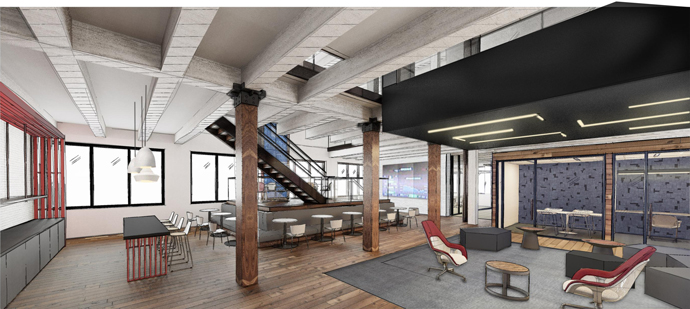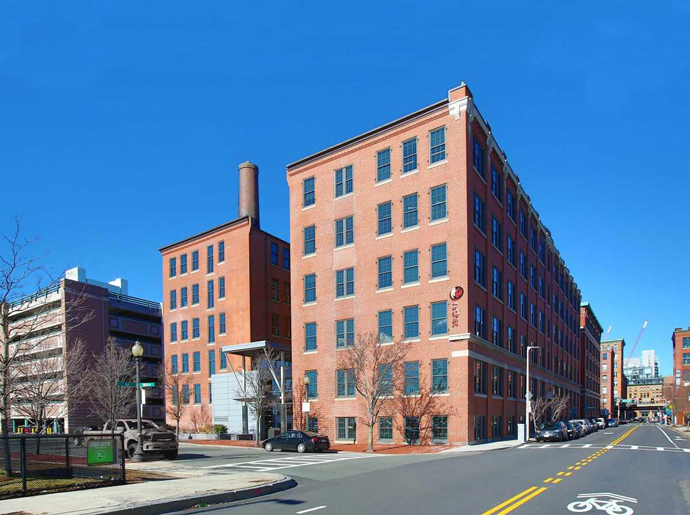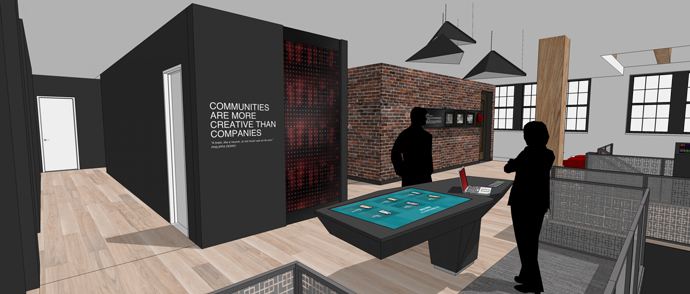The location decision-makers at Red Hat — the innovative open-source software solutions company based in Raleigh, North Carolina — have never eaten at Boston’s famous Red Hat Restaurant on the waterfront. But they’re going to have plenty of chances to encounter their company’s namesake going forward.
That’s because the company on September 15 announced its plans to expand its Boston footprint to a new location in the Fort Point neighborhood of Boston’s Seaport District. The site, not far from GE’s newly relocating headquarters, will host an executive briefing center, a new engineering lab, and the first US East Coast location for Red Hat Open Innovation Labs. Expected to open in mid-2017, the facility adds 40,000 sq. ft. to the company’s Massachusetts portfolio, which mostly consists of a 175,000-sq.-ft. worldwide engineering and product headquarters located in Westford on Boston’s perimeter.
“Boston is home to one of the world’s most dynamic tech communities, and students coming out of its world-class universities have grown up on open source and Linux,” said Paul Cormier, president, Products and Technologies, Red Hat. “Our facility in Boston will be designed to give open source innovation a global stage and help drive the next wave of open source engineering advancements and customer initiatives.”
The company just introduced its Open Innovation Labs concept in April, with a pilot in Mountain View, California. It’s a residency-based initiative for “helping customers jumpstart modern application development,” says Red Hat. “Red Hat Open Innovation Labs participants learn how to build and containerize applications on Red Hat OpenShift Container Platform while working closely with Red Hat subject matter experts to understand and integrate DevOps approaches and methodologies.”
The day after the announcement, Site Selection talked to Simon George, senior director of workplace solutions at Red Hat. He oversees a global portfolio of 1.6 million sq. ft. across 90-plus offices in 37 countries. Three-quarters of that portfolio is at 19 sites, with several very large offices. The global geographic split is about 55 percent North America, about 22.5 percent each in Asia Pacific and EMEA, and 3 percent in Latin America, says George.

“About 7,500 associates reside within our real estate portfolio, and about 2,500 are considered remote,” he says. “The whole portfolio is leased — we do not own any real estate as a company.”
But they certainly own the process of evaluating it.
“We are constantly looking at our real estate portfolio,” George confirms. “Every single office at some point gets looked at, multiple times a year. We are constantly evaluating headcount, working with internal business partners, looking at where we should be placing people. It all comes down to where we can access talent, and of course the right markets to access customers.”
Why the Hub Made Sense
George says the Boston decision boiled down to three distinct requirements, beginning with the need for a Boston presence to more directly attract and retain the talent flowing out of the city’s great universities than the company has been able to do in Westford, which is “45 minutes without traffic from downtown Boston,” says Winchester. And there’s always traffic. Engineering top brass and thought leadership will remain in Westford.
“This does not change our Westford office in any way, shape or form,” says George. “We just realized we were missing out on a talent pool in the Boston area. Trying to get millennials to own a car and then drive out just wasn’t happening.”
Next came the need for the open innovation lab so customers can come in for long-term engagements (lasting from a week to sometimes several months) to solve specific business problems. And the executive briefing center was high on the wants and needs list too.
“Those have to be in cities with great transportation, close to an international airport, and also have good hotels, dining and be in an international city,” George says.
Bringing all those things together in Boston just made sense. The big debate was whether to put them under one roof. While some turning points in location choice revolve around incentives or imminent lease terminations, this one was totally an inside job.
“The real turning point was gaining internal alignment that the three distinct requirements need to be under one roof,” says George. “Once we gained that alignment, this project came to life. I remember being in Westford just before Christmas. It was a three-hour meeting, and finally we walked out in alignment.”
Many of the company’s technology peers already have technology centers in the Boston market, and the demographic of millennials and what George calls “very, very qualified candidates” in the metro area, especially within the Back Bay and Cambridge neighborhoods, “is just staggering.”
George says the company has had its Mountain View Open Innovation Lab up and running for a couple of months, monitoring things like square footage, technology choices and whether extended customer engagements can be accommodated. “Mountain View is a couple thousand square feet,” says George, “and the one in Boston is considerably larger than that.” The labs allow Red Hat team members to understand clients’ tech challenges and “create almost a straw-man solution for them to take back to their respective companies.”
‘Great Position’
Red Hat partners with Colliers International for many of its corporate real estate needs. According to a Colliers case study, the Colliers team was first brought in by Red Hat in early 2011 for global portfolio strategy and optimization, 360 business intelligence and portfolio analytics technology, footprint scenario planning, data center strategy and transaction advisory, as well as transaction management in EMEA and APAC. “In 2012, Colliers expanded transaction management responsibilities to locations within the Americas, and in early 2013 Colliers was also selected as the exclusive global project management provider,” says the Colliers document. “Most recently in 2013, Colliers has been engaged for facilities management beginning in India, an important operation for Red Hat, and also integrating the lease administration function with Colliers 360.”
Results have included operating cost savings opportunities of approximately 7 percent of total spend, says Colliers, and the effort has captured multi-million dollar savings of approximately 19 percent of spend on executed projects.

Red Hat also brings its own staff to the table from the Americas delivery team of George’s global workplace group, IT (“a huge stakeholder in this project”), HR (“integral in getting our headcount data”), engineering and services, and legal (both internal and external counsel). Together with them, George’s team looked at a wide selection of different spaces. Due diligence was still thorough, but the team also had to quickly hone in on a handful of spaces in a very tight market, ultimately choosing 300 A Street. While some partners have yet to be chosen, George says Red Hat has hired an executive briefing center design firm.
The company also continues to grow at its tower in downtown Raleigh, where it moved into 386,000 sq. ft. four years ago from space at North Carolina State University’s Centennial Campus. “Like all of our sites globally, Raleigh continues to grow in both headcount and revenue,” says George. “It’s a great position to be in. I joke with my team that it’s called job security.”
They still need to make their first trip to choose from such delicacies as the New England clam chowder and baked haddock on the menu at the century-old Ole Scollay Square’s Red Hat Restaurant. But as for the new Red Hat in Boston, George says, “We believe we’ve made the perfect choice to meet our needs.”

